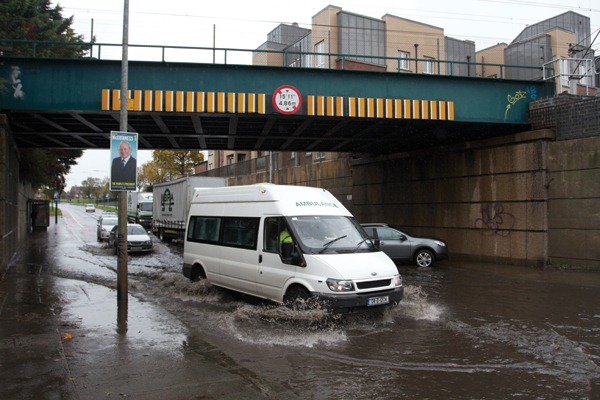Living with flooding
Peter Cheney considers how Ireland’s response needs to adapt as climate change increases the frequency of floods.
October’s flash floods, which claimed two lives and brought Dublin to a standstill, form part of a growing problem for riverside and coastal communities. Floodwaters struck across the island but hit the capital hardest, with nearly a month of rainfall falling in 24 hours. In the 2009 floods, much of Cork city was left without running water for days.
A new daily record of 82.2mm was recorded at Casement Aerodrome on 24 October. 65.7mm of rain was recorded between 3pm and 7pm, a one-in-80 year event. Measurements at Dublin Airport and Phoenix Park (69.1mm and 71.3mm) would be seen once every 20-25 years.
The Office of Public Works (OPW) is the lead agency for tackling flooding and Minister Brian Hayes is reviewing the response, which he claimed was inadequate in places. The office collects hydrographic information, gives advice on preparing for and dealing with flooding (www.flooding.ie) and holds an extensive online archive (www.floodmaps.ie).
It funds arterial drainage and flood relief schemes, to be constructed by local authorities.
Dr Conor Murphy, a climate change academic at NUI Maynooth, told eolas that defences should be designed with the increased likelihood of flooding in mind. Facilities such as power plants and shopping centres will need to adapt accordingly.
Murphy also pointed out the difference between ‘hard’ and ‘soft’ approaches to the problem. “The engineering approaches take a big sunk investment early on and they represent a large commitment of resources in flood defences,” he commented.
However, softer options can include making room for the river in land use management and putting multiple flood defences in place after an early warning is given, thus allowing a lead-in time to mobilise the emergency services and evacuate householders: “It’s more about living sustainably with the floods than trying to get them out of the way.” He remarked: “In many cases, the more we invest in trying to tame nature, the breach of a flood defence can be much greater.” New Orleans in 2005 is a case in point.
In 2008, Dublin City Council was granted permission to build a 3km long embankment in Clontarf with an average height of 1.7m. The area was hit by tidal flooding in 2002 and 2004. Work was due to start in 2012 and the estimated cost is €9.7 million. Following protests from householders and businesses, the council pledged to consider a reduction (by 50cm) but emphasised that this may not be possible. The structure would also carry a new arterial water main.
Opponents claim that they were not properly consulted and the wall will block residents’ views of Dublin Bay and walkways in the area, therefore posing a security risk. Some prefer a more aesthetic barrier used in Waterford City Council (a steel-framed wall of reinforced glass), which would be more costly. Over 3,000 people attended a protest in October and the matter has now been referred to the OPW.






